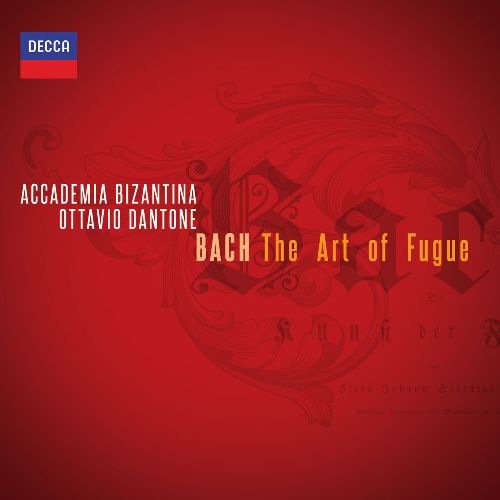
Accademia Bizantina, Ottavio Dantone - J.S. Bach: The Art of Fugue (2017) CD-Rip
BAND/ARTIST: Accademia Bizantina, Ottavio Dantone
- Title: J.S. Bach: The Art of Fugue
- Year Of Release: 2017
- Label: Decca
- Genre: Classical
- Quality: FLAC (image+.cue,log,scans)
- Total Time: 76:57
- Total Size: 462 Mb
- WebSite: Album Preview
Tracklist:
Johann Sebastian Bach
The Art of Fugue, BWV 1080
01. Contrapunctus 1
02. Contrapunctus 2
03. Contrapunctus 3
04. Contrapunctus 4
05. Contrapunctus 5
06. Contrapunctus 6, a 4, im Stile francese
07. Contrapunctus 7, a 4, per Augmentationem et Diminutionem
08. Contrapunctus 8, a 3
09. Contrapunctus 9, a 4, alla Duodecima
10. Contrapunctus 10, a 4, alla Decima
11. Contrapunctus 11, a 4
12. Contrapunctus 12, a 4 (Rectus)
13. Contrapunctus 12, a 4 (Inversus)
14. Contrapunctus a 3 (Inversus)
15. Fuga a 2 Clav. (Rectus del Contrapunctus a 3)
16. Canon per Augmentationem in contrario motu
17. Canon in Hypodiapason
18. Canon alla Decima, Contrapuncto alla Terza
19. Canon alla Duodecima, in Contrapuncto alla Quinta
20. Fuga a 3 Soggetti
Performers:
Accademia Bizantina
Ottavio Dantone
Johann Sebastian Bach
The Art of Fugue, BWV 1080
01. Contrapunctus 1
02. Contrapunctus 2
03. Contrapunctus 3
04. Contrapunctus 4
05. Contrapunctus 5
06. Contrapunctus 6, a 4, im Stile francese
07. Contrapunctus 7, a 4, per Augmentationem et Diminutionem
08. Contrapunctus 8, a 3
09. Contrapunctus 9, a 4, alla Duodecima
10. Contrapunctus 10, a 4, alla Decima
11. Contrapunctus 11, a 4
12. Contrapunctus 12, a 4 (Rectus)
13. Contrapunctus 12, a 4 (Inversus)
14. Contrapunctus a 3 (Inversus)
15. Fuga a 2 Clav. (Rectus del Contrapunctus a 3)
16. Canon per Augmentationem in contrario motu
17. Canon in Hypodiapason
18. Canon alla Decima, Contrapuncto alla Terza
19. Canon alla Duodecima, in Contrapuncto alla Quinta
20. Fuga a 3 Soggetti
Performers:
Accademia Bizantina
Ottavio Dantone
Bach's The Art of the Fugue, BWV 1080, was apparently his final work, breaking off unfinished in what would have been a monumental final section. It is written in open score, with no indication of instrumentation, which has given rise to various solutions: performances exist for organ, harpsichord, orchestra, small ensemble, and even piano, an instrument Bach is known to have encountered in his last years. But there is no recording like this one, which takes the open score as an invitation to realize the work with further creative effort, arrangement even. From the total ensemble of two violins, viola, cello, organ, and harpsichord, harpsichordist and director Ottavio Dantone and his always unconventional Accademia Bizantina deploy different combinations of instruments in the 20 fugues and canons that make up the work. Accademia Bizantina is a period-instrument group, but it can't be called a historical-performance ensemble. There's no indication that The Art of the Fugue was ever played this way (the intermittent combination of organ and harpsichord is particularly ahistorical), and Dantone offers an abstract, expressive justification for his forces rather than a historical one: he writes of an "art of hidden emotions." There is no question that playing the work this way diminishes its abstract, study-like quality (it has been argued that Bach intended it as a kind of compendium of technique, not as a work for performance) and increases its expressive qualities. Each fugue sounds different. Whether Dantone succeeds in maintaining the work's coherence will be up to the ears of the individual listener, but the procession of sounds is anything but dull: the rocking and rolling sounds of the Accademia Bizantina strings, with a trio sonata-like texture, make a compelling contrast with the keyboard settings of some of the more elaborate fugues, and Dantone's punchy harpsichord makes a further contrast with the more cerebral organ. This is a bold experiment with one of the intellectual landmarks of classical music, and there will be listeners who are not disposed toward something like that. But try it -- you might really like it.
Year 2017 | Classical | FLAC / APE | CD-Rip
As a ISRA.CLOUD's PREMIUM member you will have the following benefits:
- Unlimited high speed downloads
- Download directly without waiting time
- Unlimited parallel downloads
- Support for download accelerators
- No advertising
- Resume broken downloads


